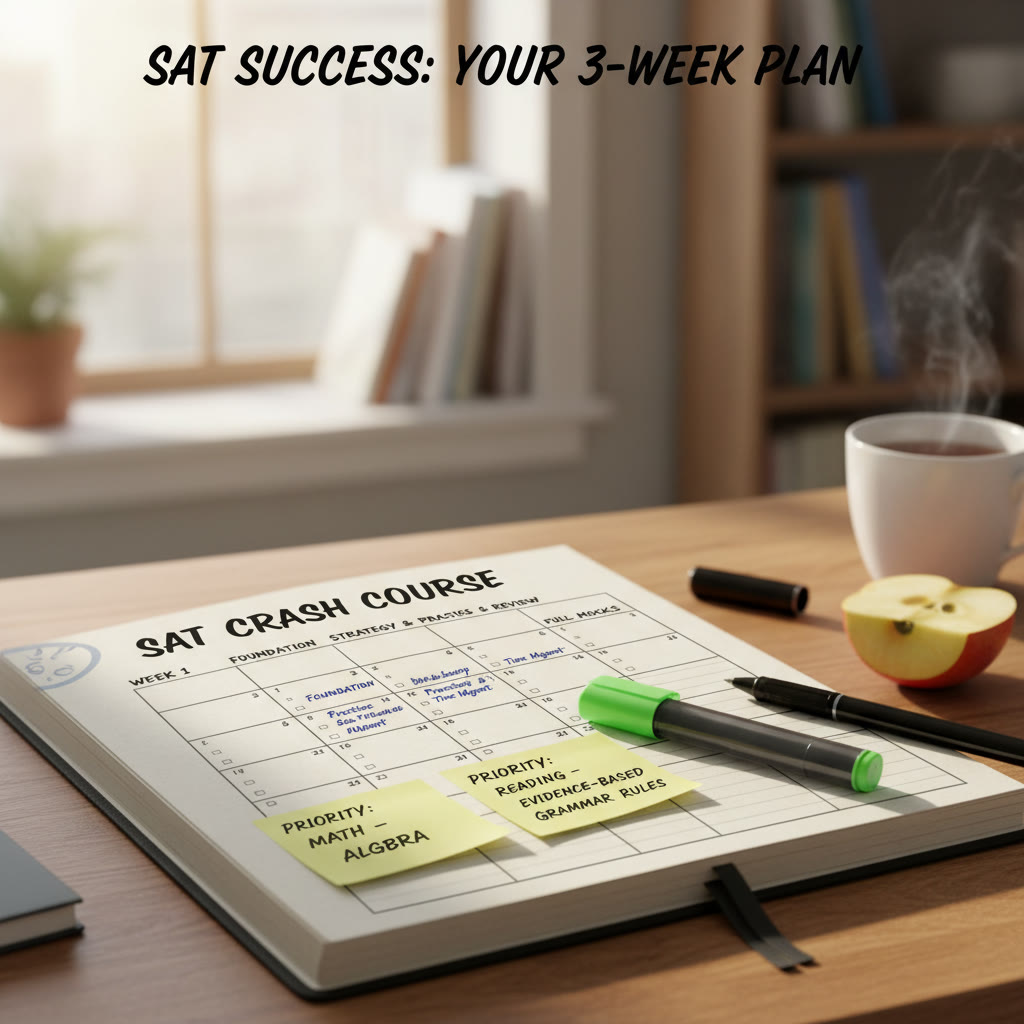Why a crash course can actually work (if you do it right)
Life sometimes hands you a deadline: a test date two or three weeks away, a college application timeline, or a last-minute decision to improve your score. A crash course doesn’t mean frantic, random studying. It means tight focus: diagnosing your starting point, prioritizing the highest-impact skills, and practicing under realistic conditions. In three focused weeks you can make measurable gains—often 50–150 points—if you spend your time wisely, rest properly, and use strategic practice.
What “crash course” really means
A crash course is not about learning every concept from scratch. It’s about triage: fix the weaknesses that most frequently cost you points, reinforce fast wins, and build stamina for test day. The SAT’s structure helps here: two main score areas (Evidence-Based Reading and Writing, and Math), each scored from 200–800, for a combined 400–1600. That focused layout means you can target specific content and timing strategies rather than trying to cover every possible corner of the curriculum.
Start with a clear, compassionate assessment
Your first hour should be diagnostic. Take a full, timed practice test to see where points are leaking. Do not anoint this test as your destiny—treat it like a map. Note question types you miss most often, timing problems, and whether careless errors or conceptual gaps dominate.
How to analyze your diagnostic
- Score by section and question type (Algebra, Geometry, Heart of the Matter, Command of Evidence, Sentence Structure).
- Time yourself in each section and see where you lost minutes. Was it the last 10 questions? That’s a pacing problem.
- Categorize errors: content error, careless mistake, misread, or strategy failure (e.g., not eliminating wrong answers).
- Prioritize two to three high-leverage weaknesses to focus on first.
Designing a three-week crash plan
Below is a practical 3-week schedule. It balances content review, targeted practice, and three full practice tests (one each week). If you have only two weeks, compress Week 1 into a single day and increase daily practice. If you have a month, extend the plan, adding deeper review and extra tests.
| Week | Main Focus | Weekly Goals |
|---|---|---|
| Week 1 | Baseline, fundamentals, timing drills | Diagnostic test, relearn key concepts, daily mixed practice (1–2 hours), one practice test at end of week |
| Week 2 | Targeted skill-building, strategy work | Focus on weak areas (math topic clusters, reading strategies), timed section practice, full practice test mid/late week |
| Week 3 | Polish, timed tests, test-day simulation | Refine pacing, do two full practice tests under test-like conditions, light review between tests, rest before the real day |
Daily routine template
Consistency beats chaos. Aim for 90–180 minutes most days (more only if you can sustain quality). Here’s a template you can adapt:
- Warm-up (10–15 minutes): quick drill or 10-question mixed set to get into test thinking.
- Focused content block (40–60 minutes): work on one weakness (e.g., linear equations, critical reading strategies, punctuation rules).
- Timed practice (30–45 minutes): take a timed section or mixed problems, then immediately review wrong answers.
- Reflection and planning (10 minutes): log mistakes, write an action item for tomorrow.
High-impact study choices by section
Not all practice is created equal. Below are high-leverage habits for each section so your limited time produces real improvements.
Math (No Calculator and Calculator)
- Master algebra fundamentals first: linear equations, systems, ratios, percent, and function interpretation. These appear often and are quick to review.
- Practice the no-calculator mindset. Use mental math and estimation for the No Calculator portion; learn a few speed tricks (e.g., factor recognition, variable isolation shortcuts).
- Drill data interpretation, coordinate geometry, and simple trigonometry as needed; they’re common and predictable on the SAT.
- Work on problem translation: turn word problems into equations precisely. Many misses come from mistranslation rather than math skill.
Example drill (10–15 min): translate five word problems into algebraic expressions, solve two under time, and review translation errors.
Evidence-Based Reading
- Practice active reading: annotate the passage structure (main idea, tone, evidence) in the margins or with short mental notes—one or two words per paragraph.
- Work on main idea and inference questions first. If you can nail the author’s purpose and passage structure quickly, other questions unlock faster.
- Train the “line-reference” technique for evidence questions: find the quoted line, read the surrounding 1–2 sentences, then look at answer choices.
- Build stamina: reading sections are long and dense; timed practice builds concentration and speed.
Example exercise: take a single passage, annotate its structure in 3–4 bullets, then answer five questions with a 12-minute timer.
Writing & Language
- Focus on grammar patterns: subject-verb agreement, pronoun clarity, verb tense consistency, punctuation usage (commas, colons), and sentence placement.
- Practice rhetorical skills: improve sentence structure, logical flow, and paragraph cohesion. Many questions test how a sentence fits into the passage, not just grammar.
- Do error-spotting drills: find the reason an answer is wrong rather than memorizing rule lists.
Pacing and timing: the science of finishing
Running out of time is one of the most common score killers. The SAT doesn’t penalize guessing, so leaving blanks is costly. Your goal is to finish every section while maintaining accuracy.
Practical timing targets
- Do a timed split: practice the first half of a section strictly timed for speed; practice the last half focusing on accuracy. Alternate weekly.
- Use the 1-pass strategy when you’re learning: answer all easy/medium questions quickly, mark hard ones, then return. As you get faster, aim for a two-pass structure that leaves 10–12 minutes at the end to attack marked problems.
- Learn smart guessing: eliminate as many choices as possible, then make an educated guess. Never leave a question blank.
The role of practice tests—and how to use them wisely
Practice tests are the backbone of any crash course. They build endurance, reveal progress, and teach pacing. But every practice test becomes useful only if you review it carefully.
How to review a full test
- Score it under realistic conditions wherever possible.
- Spend at least as much time reviewing as you spent taking it—if you took 4 hours, plan 4 hours of review spread across two days.
- For each missed question, write down why you missed it (content, careless, time, misread) and one concrete action to prevent the same mistake.
- Track error patterns on a single sheet: repeated mistakes indicate where to spend your daily focused blocks.
Sample 3-week daily schedule (detailed)
The table earlier gave a bird’s-eye view. Below is a sample daily breakdown for Week 2—when most students do heavy skill work. Adjust hours to match your life and energy levels, but keep consistency.
| Day | Morning | Afternoon/Evening |
|---|---|---|
| Monday | 30 min warm-up + 60 min Math focused on algebra | 45 min Reading passage practice + 20 min review of errors |
| Tuesday | 30 min grammar drills + 60 min Writing & Language | Timed Math section (No Calculator) 25 min + review |
| Wednesday | Full timed Reading section (65 min) practice | 50 min targeted math problem sets + 20 min reflection |
| Thursday | Timed Writing & Language section (35 min) + review | 60 min mixed problem set with pacing focus |
| Friday | Mini diagnostic: timed 25-question mixed set (60 min) | 50 min review of week’s errors + plan next week |
| Saturday | Full practice test under test-like conditions | Light review and rest |
| Sunday | Rest morning; 60 min review of hardest topics | Prep logistics for next week (materials, schedule) |
Practical tips: what most students forget
- Simulate test conditions: practice in one sitting, with the same breaks, and minimal distractions. It trains focus and reveals real stamina limits.
- Night-before: do light review, get good sleep, and collect logistics (admission ticket, ID). Avoid heavy new learning the day before.
- Nutrition matters: steady blood sugar supports concentration. Avoid a huge carb crash right before the test—favor protein, complex carbs, and hydration.
- Use error logs like a map. If you keep repeating the same mistake, your study method is mismatched to the problem. Change how you practice that topic.
When to get help—and what that help should do
If your self-study stalls or you don’t have time to orchestrate the plan, personalized help is a high-leverage choice. The right tutor or program quickly narrows the focus, provides accountability, and gives targeted strategies to avoid wasting time. For example, Sparkl’s personalized tutoring and benefits—1-on-1 guidance, tailored study plans, expert tutors, and AI-driven insights—can accelerate a crash course by ensuring your limited hours target the exact skills that will raise your score fastest. Use tutoring for weekly check-ins, rapid diagnostics, or targeted lessons on stubborn topics.
Mindset: staying calm and focused
Short-term prep is stressful, but panic makes you inefficient. Small rituals help: a 5–10 minute warm-up before a study block to focus, a short walk between sessions to recharge, and a simple progress log so you can see gains. Celebrate small wins: a faster timing on a section, fewer careless errors, or understanding a difficult concept. Those wins compound.
Test-day mindset hacks
- Begin each section with a calm 10-second ritual: deep breath, scan the section to note question types, then attack the easiest ones first.
- If you get stuck, flag the question and move on—your time is more valuable than obsession on one problem.
- Remember there’s no penalty for guessing. Eliminate wrong answers, pick your best choice, and move on.
One-week condensed plan (if you’re down to 7 days)
If you truly have only one week, compress the three-week schedule. Spend Day 1 on a diagnostic and immediate review of the top three weaknesses. Days 2–5 alternate two focused content blocks per day (math in the morning, reading/writing in the afternoon), include two timed full sections, and keep short daily mixed practice. Day 6: full practice test. Day 7: light review and rest. This is intense—protect sleep and nutrition to maintain performance.
Final checklist for the week before the test
- Complete at least two full, timed practice tests under realistic conditions.
- Master your test-day logistics: ID, test center route, materials (approved calculator, pencils, snacks), and backup plan.
- Reduce new learning. Focus on quick wins and steadying nerves.
- Keep a short error log of 10–20 things to glance at the morning of the test—formulas, grammar rules, mental math reminders.
- Plan sleep: aim for consistent 7–9 hours on nights leading up to the test.
Image ideas


Parting advice: focus, not frenzy
A crash course is a sprint with a clear game plan, not a chaotic cram session. Use diagnostics to guide you, choose high-impact work over endless content review, and respect rest. If you find yourself overwhelmed, short targeted support—like 1-on-1 guidance from a tutor who can build a tailored study plan and provide timely feedback—can be the difference between spinning wheels and steady progress. With disciplined practice, accurate review, and realistic pacing, you can enter test day confident and ready to perform.
Keep this plan flexible: adapt days to your needs, emphasize your weaknesses, and trust the small, daily habits. Good luck—stay focused, sleep well, and tackle each section with the steady confidence of a student who prepared with intention.
















No Comments
Leave a comment Cancel